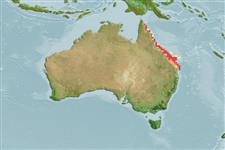Teleostei (teleosts) >
Perciformes/Scorpaenoidei (Scorpionfishes) >
Scorpaenidae (Scorpionfishes or rockfishes) > Pteroinae
Etymology: Brachypterois: Greek, brachys, eia = short + Greek, pteryx, = fin (Ref. 45335); curvispina: Name refers the dorsally curved posterior lacrimal spine present in large adults, a diagnostic character.
Environment: milieu / climate zone / depth range / distribution range
Ecology
Marine; pelagic-neritic; depth range 32 - 130 m (Ref. 93969). Tropical; 12°S - 26°S, 142°E - 154°E (Ref. 93969)
Distribution
Countries | FAO areas | Ecosystems | Occurrences | Point map | Introductions | Faunafri
Western Pacific: Australia (Queensland).
Size / Weight / Age
Maturity: Lm ? range ? - ? cm
Max length : 12.6 cm TL male/unsexed; (Ref. 121532); max. published weight: 26.00 g (Ref. 121532)
Short description
Identification keys | Morphology | Morphometrics
Vertebrae: 24. This species is distinguished by the following set of characters: pectoral-fin rays 14-16 (modally 15); scale rows in longitudinal series 41-45 (44); scales above lateral line 4-5 (4); scale rows between last dorsal spine base and lateral line 4-5 (4); pre-dorsal scale rows 3-5 (4); suborbital scale rows 0-2 (1); total gill rakers 16-18 (16); head length 41.5-44.5 (mean 43.1) %SL; orbit diameter 13.0-15.4 (14.3) %SL; upper-jaw length 20.2-23.0 (21.6) %SL; longest dorsal-fin soft ray length 19.5-24.5 (22.5) %SL; longest anal-fin soft ray length 23.6-28.4 (25.3) %SL; caudal-fin length 37.8-46.4 (42.3) %SL; posterior lacrimal spine usually directed posteriorly, the tip strongly curved upward in large adults; spine(s) on corner of outer angular ridge longer and stouter than others on ridge, directed posteriorly; number and size of caudal fin spots moderate, 5-13 (mean 9.3) spots on longest caudal-fin ray (Ref. 93969).
Life cycle and mating behavior
Maturity | Reproduction | Spawning | Eggs | Fecundity | Larvae
Matsunuma, M., M. Sakurai and H. Motomura, 2013. Revision of the Indo-West Pacific genus Brachypterois (Scorpaenidae: Pteroinae), with description of a new species from northeastern Australia. Zootaxa 3693:401-440. (Ref. 93969)
IUCN Red List Status (Ref. 130435: Version 2024-1)
Threat to humans
Harmless
Human uses
Fisheries: bycatch
Tools
Special reports
Download XML
Internet sources
Estimates based on models
Phylogenetic diversity index (Ref.
82804): PD
50 = 0.6250 [Uniqueness, from 0.5 = low to 2.0 = high].
Bayesian length-weight: a=0.01202 (0.00616 - 0.02345), b=2.90 (2.73 - 3.07), in cm total length, based on LWR estimates for this species & (Sub)family-body (Ref.
93245).
Trophic level (Ref.
69278): 3.7 ±0.6 se; based on size and trophs of closest relatives
Resilience (Ref.
120179): High, minimum population doubling time less than 15 months (Preliminary K or Fecundity.).
Fishing Vulnerability (Ref.
59153): Low vulnerability (10 of 100).
